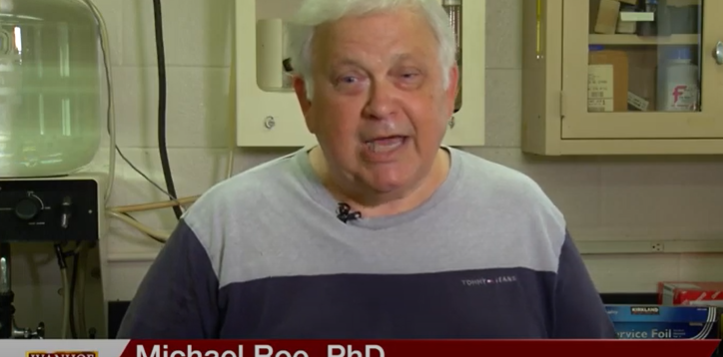Professor Michael Roe, PhD, William Neal Reynolds Distinguished Professor and Entomologist, and Grayson Cave, PhD graduate student at N.C. State University, talk about an innovative, new clothing material that prevents mosquito bites.
Interview conducted by Ivanhoe Broadcast News in May 2022.
What are you and your colleagues studying in terms of mosquitoes and materials?
PROF ROE: When mosquitoes bite, it’s uncomfortable because there’s an irritation associated with the biting of the mosquito. It’s actually injecting saliva into your body, and it causes irritation after the bite that itches and stuff like that. But at the same time, mosquitoes transmit a lot of different types of diseases – malaria, which is a protozoan – different types of viruses. There’s a risk to human health. Zika was a good example that was important to a lot of people in the United States a few years ago. So, we’re trying to prevent mosquito biting. And a lot of people don’t realize it, but mosquitoes can bite through clothing; it doesn’t necessarily just bite open skin, but they can bite through your pants legs, your shirt that you might be wearing. They typically like to bite you around your ankles, on your back, that kind of thing. So, we’re trying to develop a way to prevent mosquitoes from biting through clothing without using chemical insecticides. A lot of the bite-proof clothing that’s available today and what’s used by the military services is impregnated with an insecticide. Often, it’s a compound called Permethrin that originally was derived from a natural product found in chrysanthemum flowers, but now it’s a synthetic chemical. And so, we’re trying to develop a different idea on how to prevent mosquito bites, but not using chemistry and not using insecticides.
So, the skin exposed to that chemical, is there a risk?
PROF ROE: It’s all approved by the Environmental Protection Agency and deemed to be safe. But in general, people don’t want insecticides on their skin, whether it’s considered safe or not. So, we’re trying to make that option available to the general public and look at the use of that in a military setting.
Can you walk me through what you’re doing, in terms of the materials?
PROF ROE: Surprising enough, no one’s really studied how mosquitoes interact with cloth or with a textile. So, the study has been about trying to understand the parameters that make up a cloth or a textile, the way it’s constructed, and how that affects the mosquito wanting to bite across that structure. I don’t know if you realize this, but this is like window screening like you have on your house. I’m sure most people have it. This was invented centuries ago by the Egyptians. And since then, there hasn’t been a lot of work trying to understand how insects interact with surfaces like this. We’ve developed strategies by studying how insects bite through materials to prevent them from biting and it has to do with the pore size. If we make the pore size small enough, the mouthparts can’t go through it. The thickness of the cloth affects getting to the skin. The tortuosity of the path they have to go through to get to your skin. If it’s just a straight shot, it’s much easier for the mosquito to bite you than if it has to bend its mouthparts, which it cannot. And then, there’s another thing called the spiderweb effect. Just like you don’t like to walk through certain places like that – for example, over there, you just walked into this lab here. You just walked in. You didn’t even think about it, did you? You just walked through the door, right? Because the door is designed for you to walk through it. It’s got a certain width, a height. But I can make you not want to walk through that door very easily by putting a spiderweb across the door. If there was one or two spiderwebs across that door, you wouldn’t walk through it. Insects are the same way. There are things about this cloth that they don’t like the feel of, and that could discourage them from biting through clothing. So, you put all that together and we have an amazing scientist on our team that’s a mathematician. He can mathematically define all these parameters, combining them to describe what a cloth would have to be like to prevent mosquitoes from biting.
So, you had somebody who did the math and did the computations. What did you and your team come up with?
PROF ROE: We came up with a variety of textiles that look like everyday clothing. It’ll feel good on your skin. It’ll be attractive. It won’t be crazy expensive. Yet, it would prevent mosquitoes from biting. So, we like this idea of lines of clothing that’s available to anyone that wants to buy. So, when you buy your clothing, you could have gone to the store that you purchased that and could have just as easily, with the knowledge that we’ve generated, had that clothing that would be bite proof to mosquitoes and ticks and flies and a variety of other sort of pesky insects.
How are you all conducting the tests? Also, is the material 100 percent bite proof or pretty close?
PROF ROE: We don’t like to call it 100 percent bite proof because nothing’s 100 percent in real life. But our tests are very rigorous, have greater rigor than most testing protocols that people use, but we call it highly resistant. But the bite resistance is close to 100 percent in the studies that we’ve conducted. And we have different tiers of testing. We have an in vitro system.
What does the in-vitro system do?
PROF ROE: All in-vitro means is that we take blood from an animal and put it in this device with a skin-like membrane on the surface, we stick it into a mosquito cage, cover it with cloth and see if the mosquitoes can bite through it. That level is the first level of testing. The cloth is highly resistant, let’s say 85 to 90 percent resistant, then we would go to a tier-two test where that cloth would be put on the surface of a person’s arm, then they would stick their arm in the cage. If the cloth is highly resistant with that test using the human arm, then we would go into a walk-in cage where we would surround you with 200 mosquitoes. Then, we would have someone with an entire garment on. Their head would be protected so the mosquitoes wouldn’t be biting them on their heads. Their hands would be covered, and then we would see if the full body suit or a shirt or whatever it was, we were testing, whether the mosquitoes could bite through it. Then, the fourth tier of testing is we go outside in a natural environment and see if the person is protected.
How close are you to having these garments ready for consumer use?
PROF ROE: They’re ready already. I’ll show you some garments that are currently on the market. It’s not available in mainstream sportswear yet. It could be. It’s one thing to invent something – it’s another thing to getting it in the hands of the public. That’s a whole different skill set.
Did you have to form a spinoff company separate from the university to be able to do that?
PROF ROE: There’s a spinoff company called Vector Textiles. The technology is in various stages of being patented, and that technology is licensed to a private company in the process of commercializing it.
You had mentioned one of your colleagues is also taking a global perspective and looking at how they can protect people from mosquitoes in Africa, right?
PROF ROE: Yes. Dr. Marcel Deguenon, who is a postdoc in my laboratory and got his Ph.D. from NC State University in my laboratory, he’s looking at the use of this technology in a variety of ways in the continent of Africa. There are a lot of different spin offs of this from, let’s say, a onesie to protect children the first two years of their life because most of the malaria deaths are children. So, you could easily dress them up in a onesie and they wouldn’t be bitten by mosquitoes. There are all kind of spinoffs for this, like bed nets that are not insecticidal and yet are in our studies even more effective than insecticide treated bed nets in killing mosquitoes. So, there’s a wide variety of spin offs from this research. This is a great thing about research. You start on a particular subject, and you don’t realize, wow, wait a minute, look at this. A lot of people maybe in the public don’t understand how research works. But most often, you start to do research in one area and then you find out, wait. I can go this way, or I can go this way. And you end up with things that you didn’t expect. So, another example of this is, I was showing you earlier, is we have a line now of agricultural textiles that double the rate of plant growth and allows you to grow crops without the use of insecticides. And that’s been patented. It’s been licensed to a private company for commercial development. So, this is what’s so much fun about doing this kind of work that it leads to things that are unexpected.
How did you get interested in entomology? Have you always been interested?
PROF ROE: Since I was a kid. I was the kid walking around the high school with a butterfly net. People were looking at me in a very strange way. I grew up in southern Louisiana. I’m half Cajun. My father is from the Midwest, but my mother was Cajun. So, we grew up in an environment where there were lots of mosquitoes, lots of fire ants, a lot of insects in general. And for some reason, they just captured my interest, these things that we interact with every day.
Is there anything that you would want to make sure that the public knows about what you and your colleagues are doing?
PROF ROE: People often ask me when they find out I’m a professor at NC State, “What classes do you teach?” I teach a lot of classes, a number of courses, and I teach only graduate students, people working on their Ph.D.’s. But there’s a lot of research being done at universities, and there are several examples from our university of how that research has resulted in technology that’s now changing the life of just a person on the street.
Can you explain some of the experiments that you do?
CAVE: I do a lot of different things, but one of the primary things that I do perform here is rearing the mosquitoes and thus testing them. It is my job to make sure they’re of the appropriate health, they’re of the appropriate size and appropriate numbers for when we do these testings. Then make sure that when they’re tested, they’re tested correctly. So, amongst that is using what we call the arm-in-cage test. We have a bracer that prevents all but a small strip of open space from being penetrated by the mosquitoes. This is just a rubbery substance that they cannot get through. This allows us to standardize the area that is exposed and thus the number of mosquitoes that will land and blood feed. This is perhaps the two most important parts of that because we deal with repellency and we deal with blood feeding, with the difference being repellency is will a mosquito land on an object. With some of these objects you’ll have mosquitoes land, but they will just leave immediately so, that’s repelling them. That’s how a lot of insecticides and pesticides and such work, or if you think of standard insect repellents, that’s what they’re meant to do. The insect is not going to come near you, but then, if they do, the blood feeding is the next part. Will they actually blood feed, and that’s where the bite-resistant material comes in.
How does the bite-resistant material play a part?
CAVE: Amongst other things we’ve tested – and we have a variety of different textiles and parameters we’re looking at. But for this, it is to determine how well a mosquito will bite or attempt to bite through a textile. For example, we have the four different stages. But in this lab, we perform the three different stages, the first stage being the in-vitro assay and then the arm-in-cage assay and then the full-garment assay. So, the in-vitro, although attractive, is the same as if you offered someone a piece of bread and they’re hungry – they’ll eat it, sure, but they won’t necessarily go straight for the bread. There’s nothing like an actual being for attracting the insects, so that’s what the arm-in-cage does, it gives them an access to an actual being and all the bits and chemical processes and everything that goes into making a being. If it can pass both of those; that’s amazing.
Is your arm the arm that’s going in the cage a lot of times?
CAVE: We are unable to disclose the names of human subjects.
How do you feel as you’re putting your arm in there?
CAVE: I run the in-vitro, we purposefully do not go with the arm-in-cage first, because for anyone who’s doing the testing, we want to avoid discomfort. So, the in-vitro is a way of determining how much biting is going to occur. We have a threshold where if that threshold is not reached, we will not test it in the arm-in-cage testing.
From your perspective, how important is the research that you and your colleagues are doing?
CAVE: I certainly think it’s quite important, especially in the way of we’re not trying to supplant anything. All of what we’re doing is giving additional tools in the toolbox for what we hope for to be a global thing, something that everyone will have access to and something that everyone can use. Not every screwdriver is going to be perfect in every situation. So, what we want to do is provide an Allen wrench for when you need the Allen wrench, and then when you need a screwdriver, you can use a screwdriver. A lot of the research we’re doing, like the agriculture netting that we just had a press release on, which is the bare bones showing that it works, things grow, it protects against insects. But that’s just the first layer of it. We can then take it and we can build from that. So, we can use repellents, we can use insecticides, we can use different things that then adds on and enhances existing treatments, existing technologies, and build off them and make something that’s better than the base components.
Is anything else that you would want to make sure that people know?
CAVE: I would definitely want people to know that safety and health is a big part of what a lot of us do and a lot of our colleagues do. It’s kind of funny because talking with people, they never really thought about it. When you hear about entomology, you always think of people playing around with bugs, which is what we get to do, but this is also something where we are very proud and honored to be able to do. Something that we’re all working on and we all spend a lot of time doing – sticking arms in mosquito cages or sleeping under bed nets, because we feel that a lot of this stuff is something that can help, not just ourselves, but everyone else around us and in places where they might not have as much access to a lot of the luxuries. Being able to bring these to those people so they can help and get a better baseline of life is very satisfying.
END OF INTERVIEW
This information is intended for additional research purposes only. It is not to be used as a prescription or advice from Ivanhoe Broadcast News, Inc. or any medical professional interviewed. Ivanhoe Broadcast News, Inc. assumes no responsibility for the depth or accuracy of physician statements. Procedures or medicines apply to different people and medical factors; always consult your physician on medical matters.
If you would like more information, please contact:
Lauren Barker
(910) 528-2285
Sign up for a free weekly e-mail on Medical Breakthroughs called First to Know by clicking here




